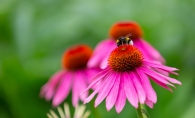In 2005, Kelsey Ness took a job at Lynde Greenhouse. After three years, she realized that what she thought was simply a job had become her vocation. “It’s a career and a passion,” says Ness, describing her work as a commercial and residential landscape designer, as “knowing that you’re making things beautiful.”
Case in point: her own home, which she purchased with her husband Scotty in 2010. When the couple moved in, there were some trees in the yard, but no gardens, pathways or edging. As two young (and busy) professionals, they wanted this outdoor space to be aesthetically pleasing but also wanted a design that required little upkeep and worked with—not against—the Minnesota climate. So, Ness approached her yard with the same strategies that she uses in designing gardens for numerous Maple Grove area residents and businesses. With her creative, experimental approach and commitment to minimal maintenance, Ness designed the outdoor space of her dreams. She is happy to share her philosophy and practice so that others can have the satisfaction of creating garden havens. These tried-and-true tips are perfect for novice and experienced gardeners alike, and they emphasize a garden that is simultaneously beautiful and sustainable. Even better, Ness’ tips are affordable, both in time and money invested.
Survey the space. Before making any plans, take time to consider your yard’s current state. Ness suggests starting with an open-ended question: “What would I like to see here?” Then consider factors that impact the property, including existing trees, building and path structures, and water features. Equally important to assessing your own yard is figuring out what you like in others’ yards. Ness suggests walking through a garden center, such as Lynde Greenhouse, to see what sparks your interest.
Consider the end game. Once you know what you might like, start to designate sections of your yard. Ness says it’s important to remember that “you don’t have to fill that entire space right away.” Instead, use block edging to section off portions of your property because you can mow right over the blocks for easy maintenance. “Then prep the area you want to plant. Don’t worry about the rest of the yard,” she says. Ness recommends using regular wood mulch to prepare the ground for planting. “Put down 3-4 inches initially…add a top layer of 1 to 2 inches once a year.” This recipe leads to effective yet simple preparation and maintenance for a beautiful Minnesota yard.
Choose your big plants. Once a portion of your property is ready to be landscaped, Ness suggests choosing trees and other large plants. Consider what will provide shade and privacy, as well as what is going to grow quickly. If you want something substantial sooner rather than later, she recommends Hakuro Nishike, a willow shrub that tends to grow easily. Also, now is the time to plan for low-growing plants around bigger trees and shrubs. Hostas are Ness’ first choice for beautiful, low-maintenance additions. She encourages the use of any hostas that catch your eye, and she also encourages you to take any plants that may be offered to you. It’s important to remember, however, that a transplant will need a little more water and care during its first year.
Pick a variety. For a vibrant garden, consider a variety of plants that thrive in different Minnesota seasons. “Irises will give you color right away in the spring,” Ness says. Lilies (Ness’ favorite flower: “You plant the bulb and don’t have to do a thing with it”) and echinacea thrive in the summer, and hostas will also bloom during the hot days. Grasses will start to have color in the fall and Ness recommends using different colored containers to hold these collections throughout the colder months. “In the winter, grasses look great against the snow,” she adds. Karl Forester and miscanthus are two go-to grass selections for Ness.
In addition to seasonal plants, consider other factors, too. Make selections that offer different colors, heights and textures to any outdoor design. Lavender hyssop attracts bees, butterflies and birds, which can add new elements to any outdoor design. “This brings nature back to your yard,” Ness says. Clematis plants add visual appeal to fences or garage walls near the back of the garden.
Get planting. Once you have your planning done, it’s time to get planting--with the right tools, of course. Ness’ essential list includes a spade shovel, hand trowel, rake and lopper or hand shearer. With these basics, a gardener should be set to prep and care for a low-maintenance garden.
Next up: purchasing plants. For a brand-new landscape, Ness emphasizes a “less is more” approach. “Smaller plants are cheaper,” Ness says. “Generic shrubs will also be cheaper. It takes more time to establish, but it will let you think about what you want for the garden.” If something doesn’t look right, move it around. “Anything can be changed,” she says.
Once you have the proper tools and the plants of your choice, the fun can begin. “Start small,” Ness encourages. “You can always work your way out [to other areas in the yard]. And if it’s getting overwhelming, call it a day.”
Ness is adamant that the process should be as fun as the finished product. Not only does this increase a gardener’s enjoyment, but it eliminates the need to have the perfect yard. She describes herself as a self-taught landscape designer. “It’s always a process,” she says. “There’s always something to change.” And that’s her best tip for creating a beautiful yard. “Saying, ‘Hey, I built that!’ makes it so much more appealing and pleasing to everyone.”









